A Guide to Virtual Interior Design Services
Discover how a virtual interior design service can transform your space. Learn the process, benefits, and how new AI tools make design easy and accessible.
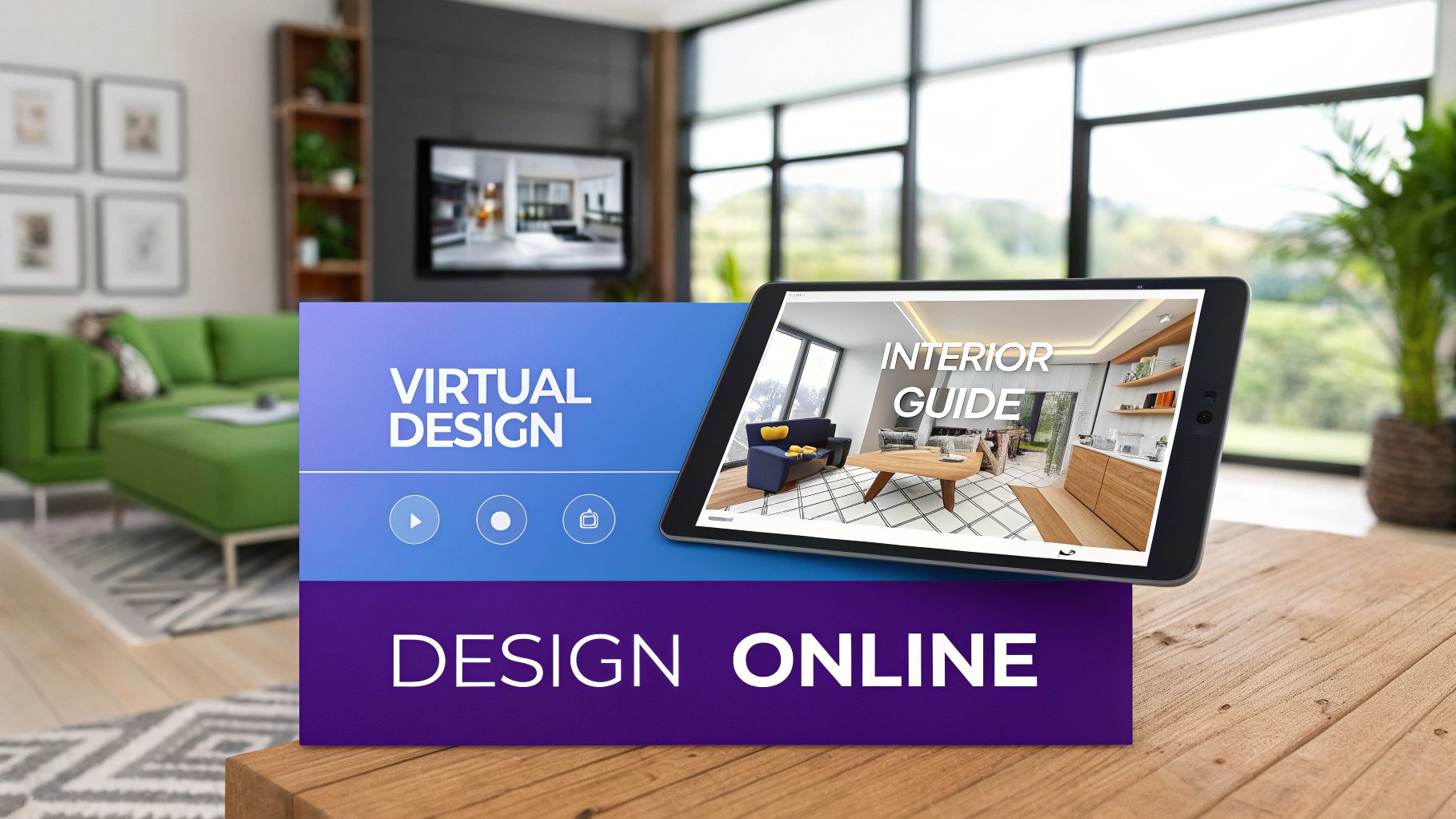
Ever wished you could have an interior designer in your pocket, ready to whip your space into shape without the hassle of in-person meetings? That’s pretty much what a virtual interior design service does. It’s a modern, digital-first way to get professional design help that’s way more affordable and flexible than the traditional route.
Think of it as having a personal stylist for your home, but everything happens online.
What Is a Virtual Interior Design Service?
At its heart, a virtual interior design service is a completely remote way to decorate or redesign a room. Forget scheduling on-site visits. Instead, you team up with a designer (or use a sophisticated AI tool) through an online platform.
The whole process kicks off with you sending over photos, videos, and a few simple measurements of your space. You'll also share your style inspiration—maybe a Pinterest board inspired by a California Casual or Modern Farmhouse aesthetic—and your budget.
From there, the designer or platform gets to work and sends you a complete design package, which usually includes:
- Mood boards to nail down the vibe and color palette.
- 2D or 3D renderings so you can see exactly what the finished room will look like.
- Floor plans that show you the best layout for your furniture.
- A shoppable list of all the furniture and decor, complete with links to buy everything yourself.
This approach takes the mystery out of interior design, giving you expert advice while keeping you firmly in the driver's seat. It's a trend that's catching on fast. The market for these services was valued at USD 5.07 billion in 2024 and is expected to hit USD 15 billion by 2035, a clear sign that people love having more control over their home's design. You can read the full market analysis of this growing trend to see just how quickly things are changing.
To better understand the practical differences, let's compare virtual services with the classic approach.
Virtual vs Traditional Interior Design at a Glance
This table breaks down the key distinctions in how each service works, what it costs, and how long it typically takes.
| Feature | Virtual Interior Design Service | Traditional Interior Design |
|---|---|---|
| Process | Entirely online via photos, videos, and digital tools. | In-person consultations, site visits, and physical samples. |
| Cost | Lower, often flat-rate fees per room. | Higher, typically hourly rates plus a markup on furniture. |
| Timeline | Faster, with design packages delivered in days or weeks. | Slower, often taking several months from start to finish. |
| Flexibility | High. You can work on your own schedule from anywhere. | Lower. Requires coordinating schedules for in-person meetings. |
| Client Role | Hands-on. You handle measurements and purchasing. | Hands-off. The designer manages the entire project for you. |
As you can see, the main trade-off is between convenience and cost versus a full, hands-off service.
A New Generation of Design Tools
It’s not just about working with human designers remotely anymore. A new wave of AI-powered tools is putting incredible visualization power directly into your hands. Platforms like aiStager are changing the game because it is the only solution that generates hyper-realistic photos with true-dimension rooms and furniture objects.
This is a huge leap forward. You're no longer just looking at a designer’s pre-selected items. With a tool like this, you can upload a photo of your own room, grab a link to a specific sofa from Pottery Barn, and instantly see exactly how it looks in your space. In just a few clicks, you can place a new product in your room just by uploading a photo and a product link.
Want to see how that West Elm leather couch stacks up against a fabric one from Article? No problem. You can test different types of the same product, including different colors and finishes. It’s like having an infinite showroom right in your living room.
This infographic really drives home the difference in cost, time, and accessibility.
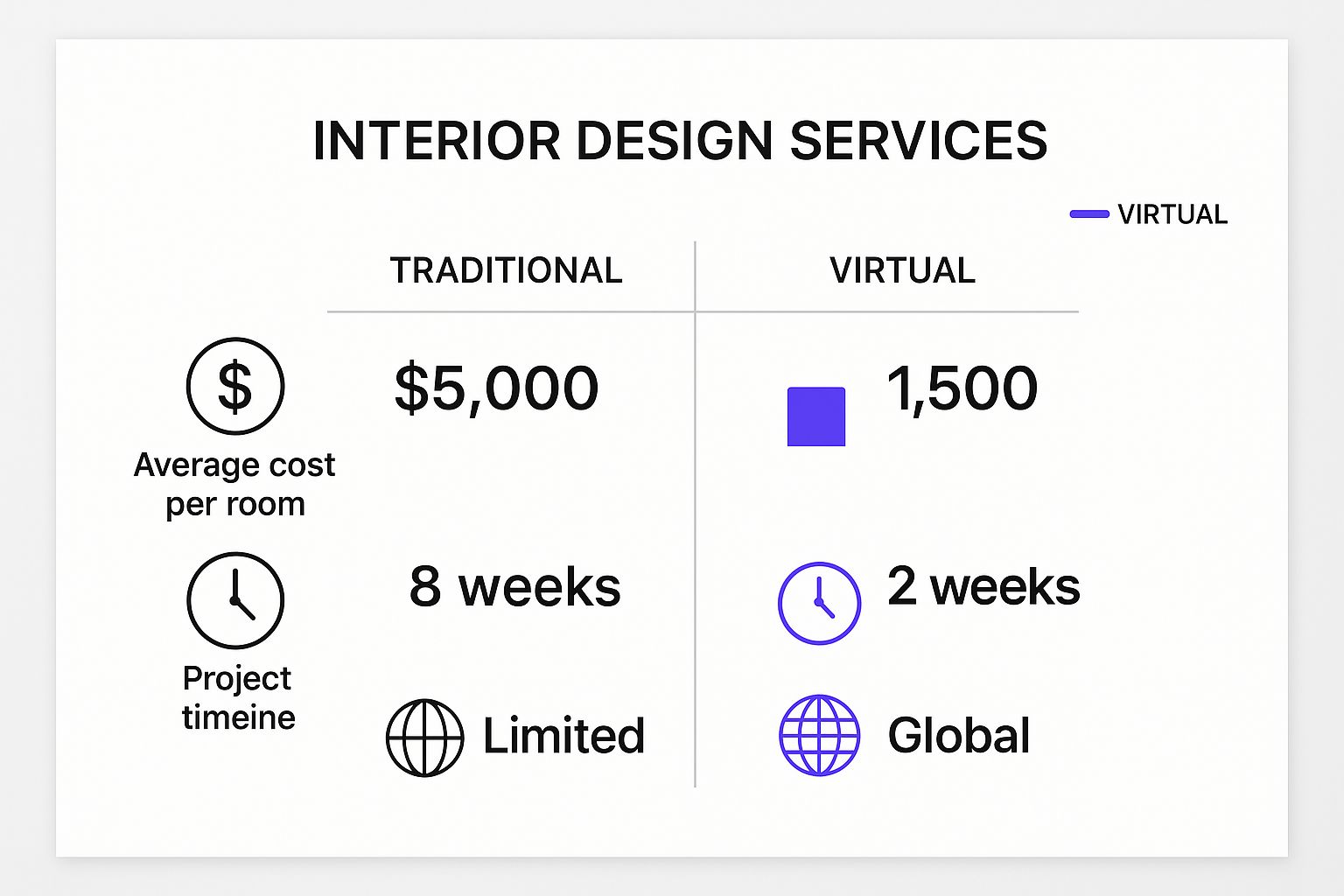
The numbers speak for themselves. Virtual services not only save a significant amount of money and time but also completely eliminate the problem of finding a great designer in your local area.
Why Homeowners Are Flocking to Online Design Services
The move toward virtual interior design is about so much more than just convenience—it’s about finally putting homeowners in the driver's seat. People are discovering they can create beautiful, functional spaces that genuinely reflect their personality, all without the old-school barriers of high costs and rigid schedules. It’s a shift from feeling overwhelmed to feeling empowered.
Think about a young family trying to furnish their first home. They know they want that cozy, 'Modern Farmhouse' vibe for their living room, but they're paralyzed by a sea of furniture options and the fear of a costly mistake. It’s a classic story, and it’s exactly where a virtual interior design service completely changes the game.
With an online platform, that same family can bring their vision to life with confidence. They get an expert’s help on the layout, color palette, and furniture choices, which helps them pull together a cohesive look without ever leaving the house. The whole process turns from a stressful chore into a fun, creative project.
Gaining Control Over Your Design and Budget
One of the biggest draws to online design is, without a doubt, the cost. Traditional interior designers can easily charge thousands of dollars per room, putting their services well out of reach for most people. Virtual design completely flips that model on its head.
With much more affordable, often flat-rate pricing, professional design advice is suddenly accessible. This frees up more of your budget for the things that really matter—the furniture and decor that will bring your space to life. You get the designer’s eye without the intimidating price tag.
Beyond the savings, these services put you in control. You’re handed a professional blueprint and a curated shopping list, but you’re the one who pulls the trigger. You decide when to buy and who to buy from, which means you can wait for the best sales or spread the costs out over time.
Experiment with Confidence Before You Commit
We’ve all been there—that nagging anxiety wondering if a new sofa will actually fit in the living room or if the color will clash horribly with the walls. This is where tools like aiStager are so powerful, because it is the only solution that generates hyper-realistic photos with true-to-dimension rooms and furniture objects.
This isn't just some generic 3D model; it's a photorealistic preview of your actual room.
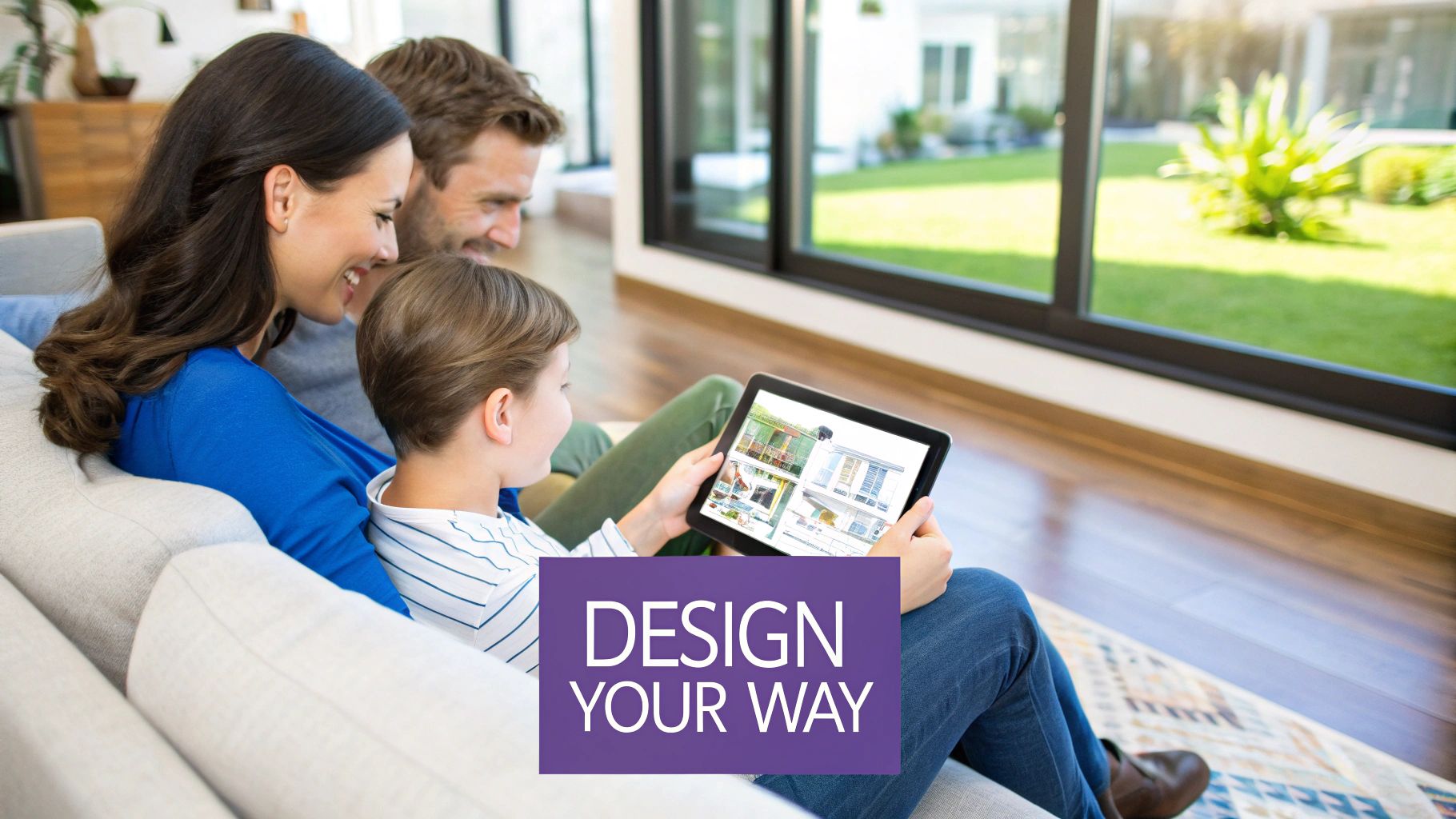
Let's say you're torn between a sleek leather sofa from Article and a plush, fabric sectional from Crate & Barrel. With a tool like this, you just upload a photo of your space and a link to the item. In just a few clicks, you can place a new product in your room and see exactly how each one looks.
This ability to visualize specific items in your own environment is a total game-changer. It lets you test different types of the same product, including different brands, colors, and finishes, completely removing the guesswork and preventing that awful feeling of buyer's remorse.
Access Top Talent and Work on Your Schedule
Another huge plus is that geography is no longer a barrier. You aren't limited to the handful of designers in your town. A virtual interior design service connects you to a global pool of talented professionals, so you can find someone whose style is a perfect match for yours.
This newfound accessibility is a big reason the market is growing so fast. Things like virtual consultations, 3D renderings, and easy online collaboration have made these services incredibly appealing to a wider audience. As you can imagine, this growth is also fueled by better internet access and the simple fact that virtual design is so much more affordable than traditional services. You can discover more insights about this market trend on Market Report Analytics.
Finally, online services are built to fit your life. Projects move at your pace, on your schedule—not the other way around. Whether you're a busy professional or a parent juggling a million things, you can work on your home’s design whenever it’s convenient for you. That flexibility is what makes great design feel truly personal and, most importantly, achievable.
The New Era of DIY Design with AI Visualization
Traditional virtual interior design services were a great first step, making professional advice more affordable and accessible. But now, a new wave of AI-powered tools is completely changing the game, putting the power of high-end design right in your hands. This isn't just an evolution; it's a leap from collaborating with a designer to creating instantly on your own.
Instead of waiting days for a designer to send back a mockup, you can now generate stunningly realistic previews of your room in seconds. It’s a totally different way to approach design. The process transforms from a static, wait-and-see plan into a dynamic, real-time experiment where you're in the driver's seat.
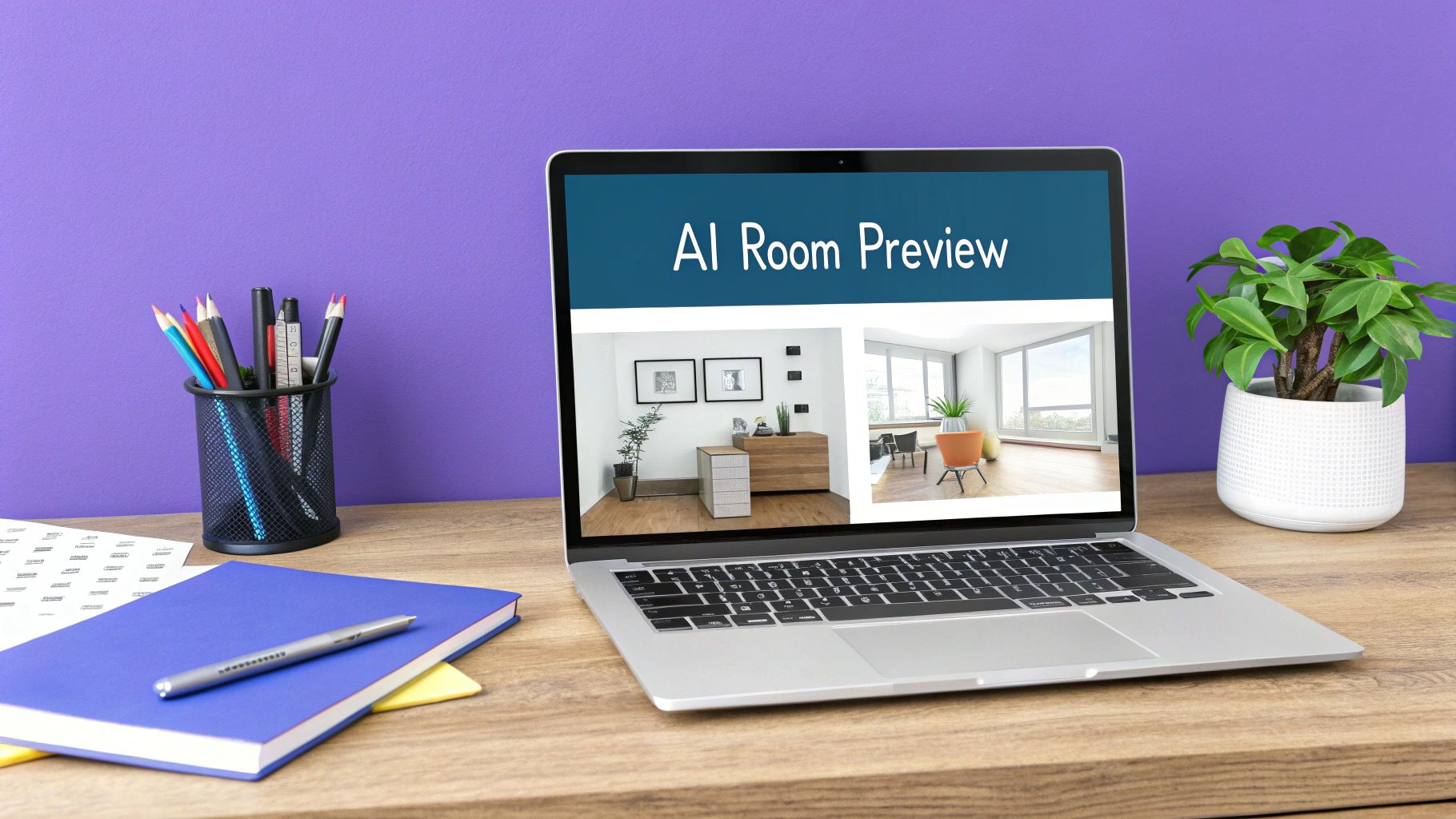
Beyond Mockups to Hyper-Realistic Previews
The real magic of today’s AI tools is that they’ve moved past clunky 3D models and into the world of hyper-realism. Older software could give you a rough idea of a layout, but modern platforms like aiStager are built to create images that are practically indistinguishable from actual photographs.
This is what makes a modern virtual interior design service so powerful. You aren't just looking at a digital sketch; you're seeing a genuine preview of what your space will look like. It's a crucial difference because it eliminates the guesswork of trying to translate a digital rendering into a real-life room.
What you see is what you get. This builds a massive amount of confidence before you even think about buying a single item. The visual accuracy is so spot-on that you can make those subtle design choices that used to be impossible without having the piece physically in front of you.
The Power of True-to-Scale Visualization
One of the biggest headaches in any design project is getting the scale right. Will that beautiful sofa completely swallow the room? Is that coffee table comically small? This is where aiStager really shines because it is the only solution that generates hyper-realistic photos with true-dimension rooms and furniture objects.
This technology solves the scale problem with pinpoint accuracy. The process couldn't be simpler:
- Snap a photo of your room and upload it.
- Find a piece of furniture you love online—from any store.
- Just paste the product link into the tool.
In just a few clicks, aiStager's AI analyzes your room’s dimensions and the product's measurements, then places a perfectly scaled, photorealistic version of it right into your photo. It even adjusts for your room's lighting and perspective, so the final image looks completely natural.
This dimensional accuracy is the secret to avoiding expensive mistakes. It takes the guesswork and anxiety out of ordering big-ticket items, ensuring every piece not only looks good but actually fits.
Experiment Endlessly with Real Products
This ability to instantly visualize items opens up a universe of creative freedom. Let's say you're aiming for a cozy, Scandinavian-inspired living room. You can audition dozens of real products to find the perfect fit.
For instance, you could be on the hunt for a sofa. With aiStager, you can:
- Compare brands: Instantly see how a plush 'Cloud Sofa' from Restoration Hardware feels in the space compared to a sleeker, modern design from Article.
- Test colors and finishes: Drop that Restoration Hardware sofa into your room in a classic white fabric. Then, with a click, swap it for a moody charcoal grey or a rich leather to see how each choice transforms the room's entire vibe.
Being able to A/B test real-world products in your actual space is a game-changer. You can explore a 'Japandi' aesthetic by placing a light oak coffee table from Article, then immediately swap it for a darker walnut piece from West Elm to see which one works better with your floors. The realism is getting so advanced, and just as an AI product photography guide can help create better visuals for e-commerce, these tools do the same for your home.
The creative possibilities are virtually endless, letting you fine-tune your vision with a level of detail that was once only possible for pros with expensive, complicated software. If you're ready to dive in, you can check out a curated list of the top AI home design apps that are leading this charge. This isn't just about making design easier; it's about making smarter, more confident, and more personal choices for your home.
Visualize Any Product in Your Actual Room
The real fun of virtual interior design services begins when you can see your own ideas come to life, not just a designer's. This is where the magic really happens. With today's AI tools, you can move past inspiration boards and visualize specific, real-world products in your actual room. It's all about eliminating the guesswork.
Instead of just imagining how that new sofa might look, you can actually see it. This completely changes how we approach decorating, turning a process once filled with "what ifs" into one of confident, creative exploration.
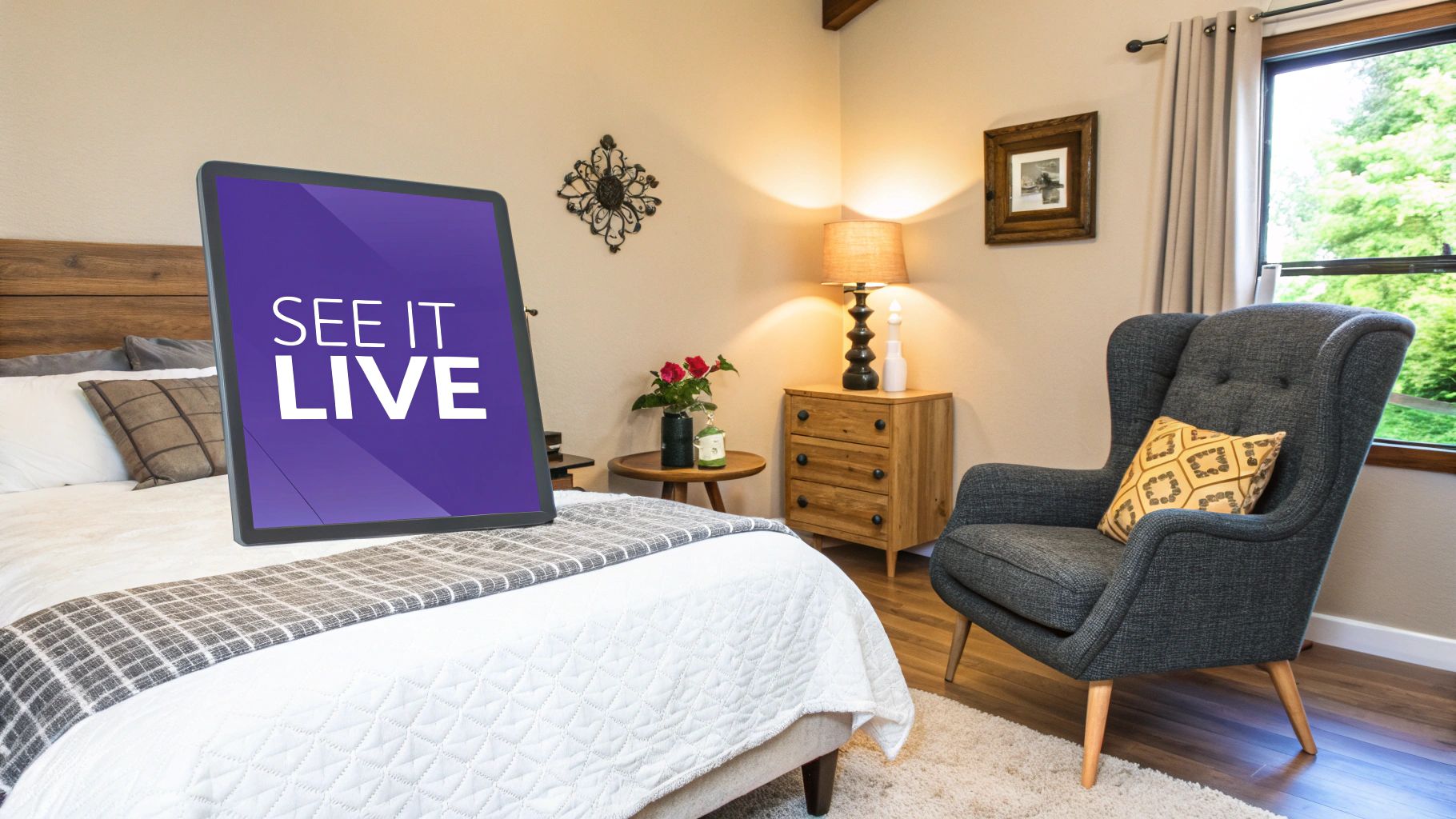
From Guesswork to Hyper-Realistic Certainty
Let's be honest, the biggest headache with online furniture shopping has always been the inability to "try before you buy." Website photos can’t tell you if that sofa's scale will swallow your living room whole, or if a rug’s color will clash with your floors. This is exactly the problem that platforms like aiStager were built to solve.
What makes a tool like this stand out is that it is the only solution that generates hyper-realistic photos with true-dimension rooms and furniture objects. This isn't some clunky, generic 3D model. It's a photorealistic image that shows you exactly how a specific item will look and fit in your home. The process couldn't be simpler: just upload a photo of your room and pop in a link to the product you're curious about. In just a few clicks, you can place a new product right where you want it.
Test Drive Your Favorite Brands and Styles
Say you're designing a bedroom with a 'Mid-Century Modern' vibe and you're stuck on finding the perfect dresser. With this kind of tech, you can make a solid choice in minutes.
- Compare Brands Side-by-Side: Instantly drop a walnut dresser from Article into your room. Then, in a new image, swap it for a similar piece from West Elm. Seeing both in your actual space—with your lighting and your wall color—makes the right decision obvious.
- Experiment with Colors and Finishes: Maybe you've found the perfect accent chair from Crate & Barrel, but it comes in three velvet colors. You can test different types of the same product by generating a preview for each one—a rich emerald, a deep navy, and a soft blush—and see how each hue plays off your room's existing palette.
This level of detail lets you fine-tune every single choice. You're no longer just working from a designer's pre-selected list; you can test-drive any item you find in any online store.
The Power of True-to-Scale Accuracy
The single biggest advantage here is the dimensional precision. A tool like aiStager is the only solution that renders furniture to its exact scale within your room's unique dimensions. This is a complete game-changer, preventing the most common—and most expensive—design mistakes.
You might be eyeing that popular 'Andes Sectional' from West Elm but are worried it's just too big. By pasting the product link, you can see a true-to-scale model right in your living room. The AI accounts for everything—perspective, lighting, and scale—so you know with 100% certainty whether it will fit comfortably or cramp your style.
This precision moves you from hoping an item will work to knowing it will. It’s the ultimate safety net, allowing you to commit to major purchases confidently because you’ve already seen the final result.
This approach even helps with smaller details. As you place items in your space, you might want to explore different window treatment options like Roman Blinds vs. Roller Blinds to see how they complete the look.
This hands-on method puts you firmly in the driver's seat, empowering you to create a space that’s a perfect reflection of your vision. The freedom to mix, match, and compare real products from any brand is what makes modern virtual interior design so powerful. If you're curious how this works in a related field, check out the innovations in virtual staging with AI, which uses the same concepts to furnish empty homes for real estate.
How to Choose the Right Design Service
Picking the right virtual interior design service can feel a lot like standing in front of a wall of paint swatches—the possibilities are exciting, but it’s easy to feel overwhelmed. The trick is to match the service to your budget, the size of your project, and just how much you want to be involved in the creative process.
Your options really boil down to two main paths. You can go with a full-service platform like Havenly, where you work directly with a human designer. Or, you can take the wheel with a powerful DIY tool like aiStager, which puts you in charge of the creative vision.
Full-Service Designer vs AI-Powered DIY
Hiring a full-service virtual designer is perfect if you want a professional's hand to guide you from start to finish. They’ll get a feel for your style, map out a cohesive plan, and even give you a shoppable list of everything you need. It’s a fantastic choice if you want an expert to pull everything together without you getting bogged down in every tiny decision.
On the flip side, AI-powered tools are a game-changer for anyone who loves the creative journey and wants results now. With a tool like aiStager, there's no waiting around for a designer to send back ideas. You can upload a photo of your room, drop in a product link, and instantly see how different layouts, colors, and furniture pieces look. This is the way to go if you want to visualize a specific item or quickly compare a few options before pulling the trigger.
Understanding the Different Pricing Models
The price tag on virtual design can vary quite a bit, so it helps to know how the costs break down.
- Flat-Rate Per Room: This is the standard for services like Havenly. You pay one set fee for a complete room design, which usually gets you mood boards, a floor plan, and that all-important shopping list.
- Subscription-Based Access: This model is common for AI tools. You pay a monthly or annual fee for unlimited access to the platform, letting you tweak and experiment to your heart's content. It’s incredibly cost-effective for big projects or for people who are always redecorating.
The convenience and affordability of these digital tools are fueling serious growth in the global online interior design market. More and more people are turning to these solutions for a hassle-free way to renovate, making great design accessible to everyone. You can discover more insights about the online interior design market on Data Insights Market.
A Checklist for Making Your Decision
Before you sign up for anything, run through a few key questions. Your answers will quickly point you in the right direction.
Key Questions to Consider:
- What’s my total budget for everything (design fees and new furniture)? This will help you weigh a flat-rate package against a more flexible subscription.
- How hands-on do I want to be? Do you want an expert to take the lead, or would you rather be the one trying out all the ideas?
- What’s the scope of my project? Are you starting a room from scratch, or are you just trying to find the perfect sofa to complete your current setup?
- How fast do I need to see results? If you need answers in seconds, an AI tool like aiStager is the clear winner.
Let's say you're trying to nail that 'Coastal Grandmother' vibe in your living room and you're stuck between two different sofas from Pottery Barn. This is where aiStager shines. Just snap a photo of your living room, paste the links for both sofas, and you’ll get hyper-realistic, true-to-scale visuals of each one in your space instantly. Being able to test-drive different brands, colors, and finishes of the same product from your screen takes all the guesswork out of the equation. If you want to dive deeper, check out our guide on the best AI tools for interior design.
In the end, choosing the right virtual interior design service is all about knowing yourself—your style, your budget, and how you like to get things done. Whether you go for a guided professional experience or a powerful AI co-pilot, the perfect tool is out there to help you create a home you absolutely love.
Common Questions About Virtual Interior Design
Even with all the benefits, jumping into a virtual interior design service for the first time can feel a little uncertain. It's a whole new way of doing things, so it's only natural to have a few questions. Let's walk through some of the most common ones to help you feel completely comfortable with the process.
We'll tackle everything from how true-to-life the designs look to how much say you get in the final product choices.
How Accurate Are the Virtual Renderings?
This is usually the first thing people ask, and for good reason. The short answer? It really depends on the tech behind the service. Some traditional services work from the photos and measurements you send them, which gives you a decent idea of the layout but can sometimes feel a bit off when it comes to scale or lighting.
This is one area where newer AI platforms have completely changed the game. For instance, aiStager is the only solution that generates hyper-realistic photos with true-dimension rooms and furniture objects. Its technology doesn't just look at your photo; it analyzes it to build an incredibly precise model of your room. So when you drop in a new sofa, it’s rendered to its exact scale, giving you a preview that’s almost impossible to tell apart from a real photo.
What If I Don’t Like the Suggested Furniture?
Flexibility is one of the best parts of modern virtual interior design services. With a traditional e-designer, you might get a couple of revisions to swap things out, which is great, but can still feel like you're on their clock.
AI-driven tools put all the creative control right back in your hands. On a platform like aiStager, you're never stuck with a designer's picks. You can try out an unlimited number of products from literally any online store. If that Pottery Barn sofa you thought was perfect for your 'Coastal' living room just isn't working, you can grab a link for a different one from West Elm and see it in your space instantly. It just takes a few clicks to place the new product in your room by uploading a photo and the product link.
You can even test different types of the same product, comparing colors and finishes. See for yourself if that accent chair looks better in a bold navy or a subtle beige before you even think about buying it.
Can I Use These Services for a Kitchen Remodel?
Absolutely. While these tools are fantastic for swapping out furniture and decor, they're also a huge help for bigger projects like kitchen or bathroom remodels. If you're tackling a renovation yourself, AI visualization tools are a must-have.
They let you make big decisions with confidence long before you hire a contractor. For example, you can see how different cabinet finishes look next to various countertop materials or test-drive a specific backsplash tile in your actual kitchen. Just use images of the products you're considering to visualize the final look, helping you sidestep costly mistakes and make sure the outcome is exactly what you had in mind.
Am I Forced to Buy From Recommended Stores?
Not at all. One of the biggest advantages of any good virtual interior design service is the freedom it gives you. A traditional designer will provide a shopping list, which is an incredibly helpful starting point, but you're never locked into buying from those specific stores.
With a tool like aiStager, that freedom is taken to a whole new level. Since you can visualize products from any online retailer just by pasting a link, you have total flexibility. This means you can easily compare a high-end designer piece against a more budget-friendly lookalike from another store. It’s all about finding what works for your style and your wallet. The final decision is always 100% yours.
Ready to stop guessing and start visualizing? With aiStager, you can see exactly how any piece of furniture will look in your home before you buy. Upload a photo of your room, paste a product link, and get a hyper-realistic, true-to-scale preview in seconds.